Alexander von Humboldt Statue
Introduction
Text-to-speech Audio
This bronze statue depicts the nineteenth-century Prussian naturalist, geographer, and explorer, Alexander von Humboldt (1769 - 1859). Humboldt is credited with shaping a nineteenth-century understanding of ecology in a Western scientific context through his travels and detailed studies of geobotany (botanical geography), climatology, geology, and other earth sciences. While exploring Ecuador's Mount Chimborazo in South America, Humboldt produced detailed, illustrated maps depicting plants in various micro-climates. He also put forward his theory of isotherms, or climates shared across different parts of the world. As Humboldt reflected on the intersection between nature and culture, his work also integrated various scientific disciplines and fields of study. A holistic, environmental thinker and popularizer of science, Humboldt wrote several influential treatises, including his five-volume Cosmos: A Sketch of a Physical Description of the Universe, which was published between 1845 and 1862. The Humboldt statue in Tower Grove Park was created by the German sculptor, Ferdinand von Miller, and was installed at the park in 1878.
Images
Alexander von Humboldt statue at Tower Grove Park
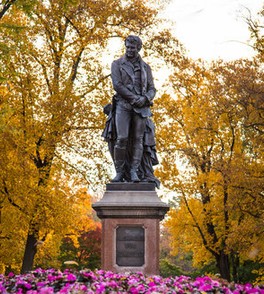
A depiction of Humboldt surrounded by flora and fauna
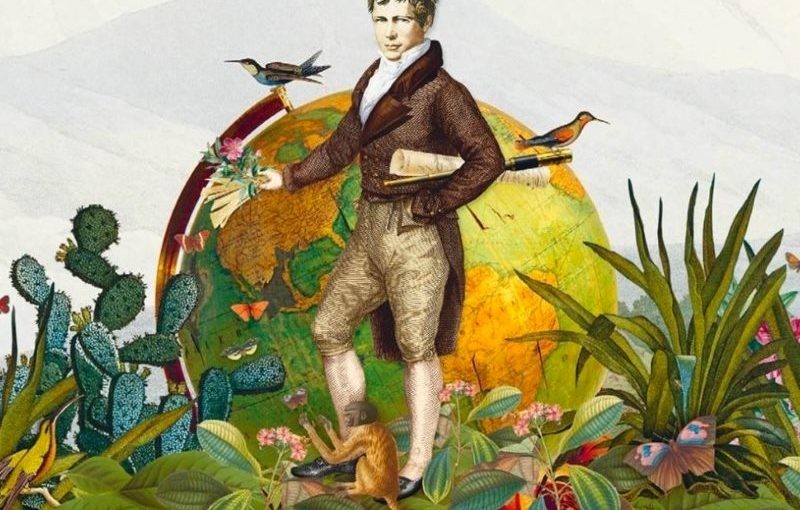
The Smithsonian American Art Museum launched an exhibition about Humboldt in 2020-21
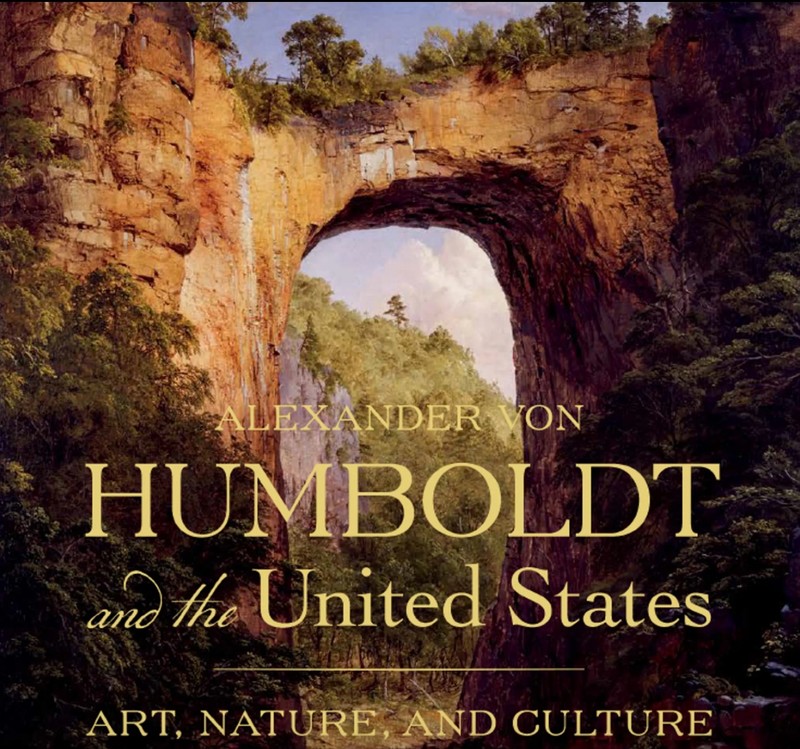
Humboldt enjoyed immense popularity in the nineteenth century, especially from 1820 - 1850, but by the twentieth century, few people knew about his life and work
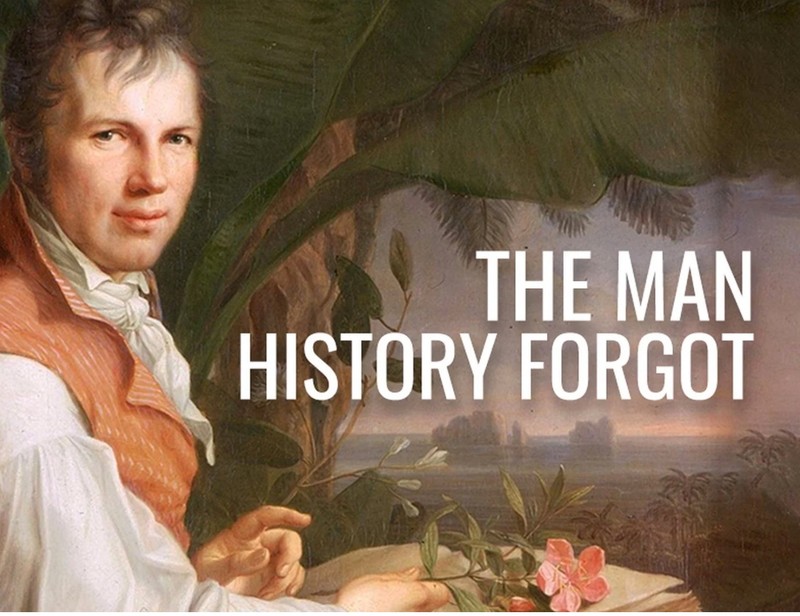
Humboldt's original drawings were a repository of information about climate, geography, geology, topography, and botany
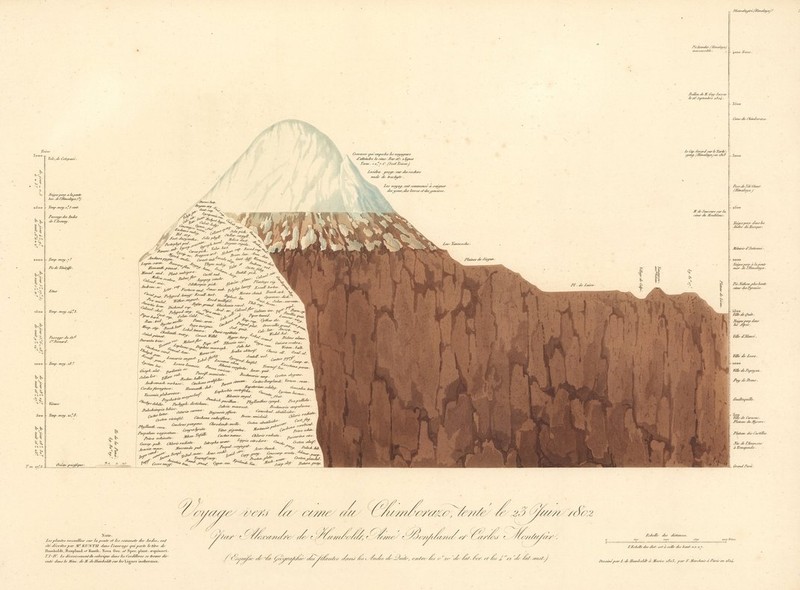
Humboldt's "Naturgemälde" or “picture of nature,” includes data about plants in their environments, compiled during his explorations in South America

Humboldt's Isotherm Map showed how climate varied depending on latitude, with climate regions relatively consistent around the globe
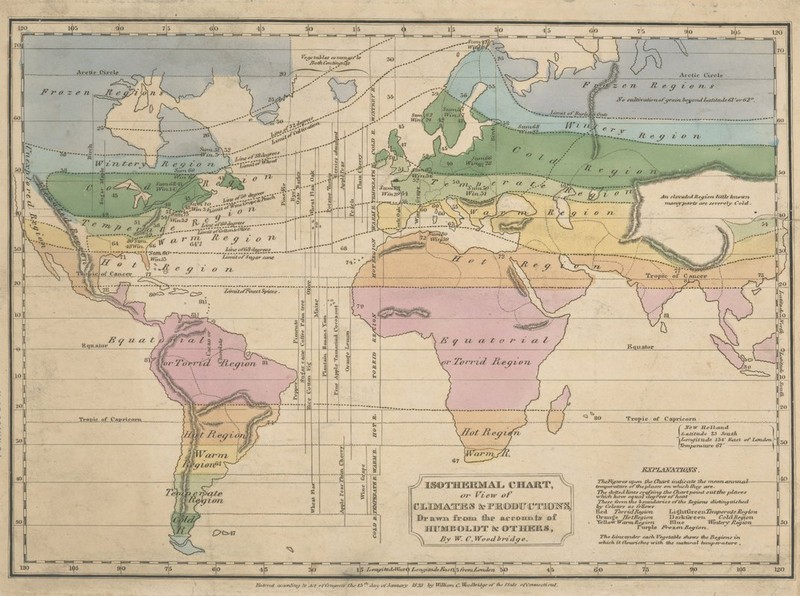
Portrait of Alexander von Humboldt
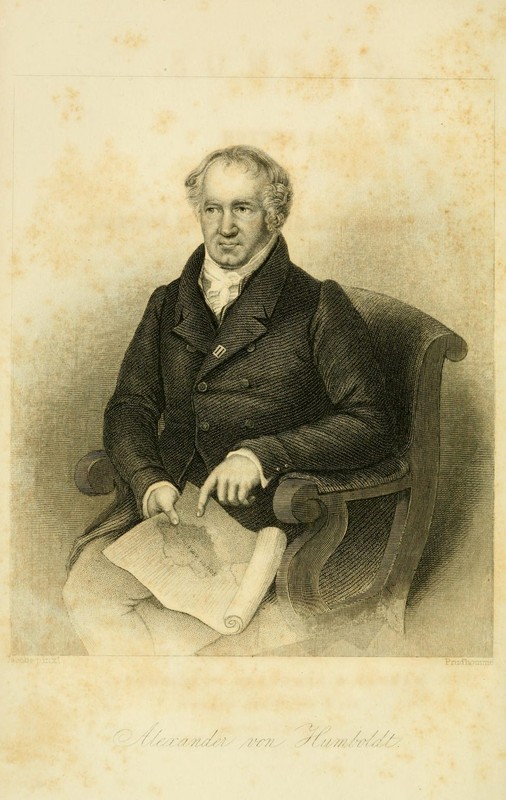
Humboldt's Botanical Geography showed plants within their environments and micro-climates
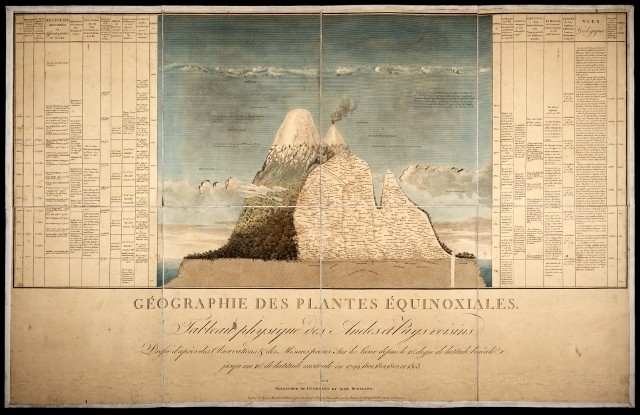
Ecuador's Mount Chimborazo, which Humboldt climbed in 1802
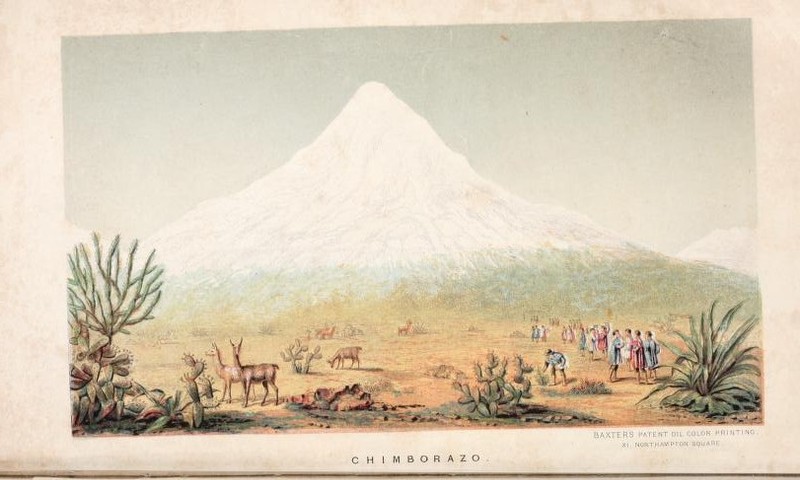
Humboldt's Botanical Geography from his expedition to the Himalayas
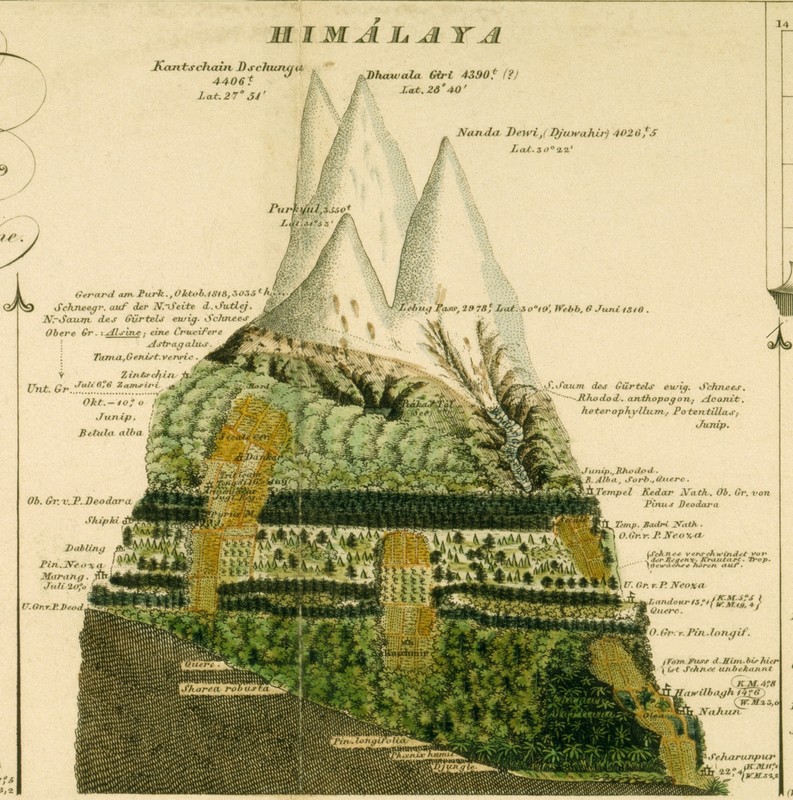
Andrea Wulf's 2015 biography of Humboldt, titled "The Invention of Nature: Alexander von Humboldt's New World"
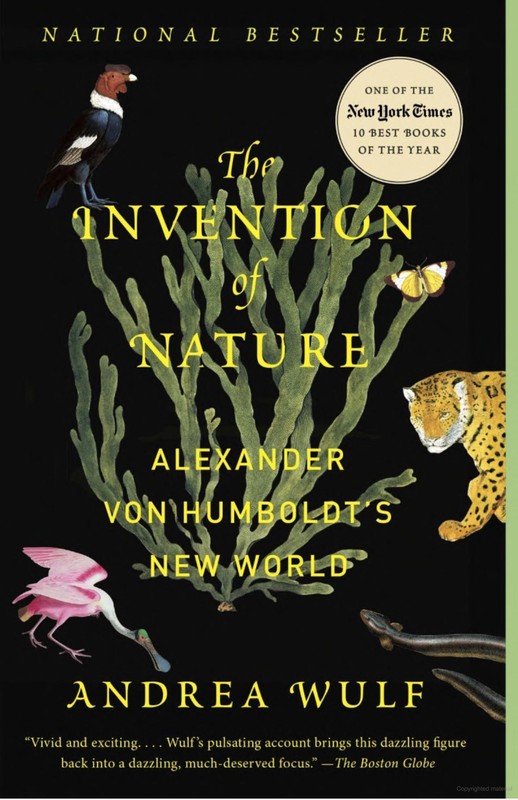
'Heart of the Andes' (1859) by the American landscape painter Frederic Edwin Church, who was inspired by Humboldt's work.
.jpg)
detail from Frederic Edwin Church's 'Heart of the Andes' (1859); he painted 100 species of plants that Humboldt had recorded

detail from Frederic Edwin Church's 'Heart of the Andes' (1859); he painted 100 species of plants that Humboldt had recorded
.jpg)
Backstory and Context
Text-to-speech Audio
This statue depicts the nineteenth-century Prussian explorer, geographer, and naturalist, Alexander von Humboldt (1769 - 1859). Initially, Humboldt trained as a geologist at the School of Mines in Frieburg before devoting himself to scientific expeditions around the world. This 11-foot statue was cast from bronze by a German artist, Ferdinand von Miller, and it sits atop a 13-foot red granite pedestal designed by George I. Barnett. The pedestal contains four bronze panels featuring details about Alexander von Humboldt's life. The first panel contains an image of Mount Chimborazo, the tallest mountain in Ecuador (which, at one time, was believed to be the tallest mountain in the world), as Humboldt was the first European to climb to this volcanic peak. With the help of local guides, he was able to reach the summit, and remarkably, he did so without the use of any supplemental oxygen. Afterwards, Humboldt created detailed drawings of the volcano's micro-climates and flora, and his work helped to establish the formal study of geobotany (botanical geography) and climatology. His maps and writings influenced numerous nineteenth-century scientists, naturalists, and philosophers, including Charles Darwin, Ralph Waldo Emerson, and Henry David Thoreau. Some of his books were read widely by general audiences, as he popularized scientific concepts.
As depicted on the statue's second panel, Humboldt was also the first known European to travel the Amazon River to its source. Although this panel was stolen in December 1974, it was later recovered and reinstalled in 1995. Humboldt's extensive notes on South America inspired the nineteenth-century landscape painter, Frederic Edwin Church, to also travel to Ecuador, where he spent nine weeks sketching landscapes in order to create his masterpiece, Heart of the Andes (1859). Based partly on Church's own sketches, it also drew heavily upon Humboldt's maps and descriptions of the region, including its mountains, rivers, valleys, flora, fauna, and human inhabitants. Church's painting depicts at least 100 specific species of plants and trees in a densely vegetated landscape of varied topography. Included in the painting are many of the same plants that Humboldt cataloged, including the passion flower, the arum flower, and the morning glory vine. In addition, Church's painting depicts a village near a river, as well as humans engaging directly with the natural world, with the overall composition portraying an integrated ecology of plant, animal, and human life in alignment with Humboldt's philosophy.
According to his biographer, Andrea Wulf, Humboldt endorsed a holistic view of nature in which he recognized the interconnectedness between peoples and cultures around the world, and between humans and nature. While traveling throughout the U.S., Humboldt decried the existence of slavery, penning an open letter that he hoped would convert President Jefferson to abolitionism. During the early 1800s, the Napoleonic Wars disrupted science in Europe, and Humboldt struggled to secure financing for his expeditions. As he eventually received funding from the Spanish Crown, some historians have examined his work in the context of nationalism. Others have focused on his contributions to nineteenth-century science, noting that Charles Darwin acknowledged being influenced by Humboldt, despite that Darwin's theory of natural selection seemed to challenge Humboldt's ecological worldview. Some scholars have highlighted Humboldt's respect for indigenous knowledge in the places he traveled, such as his reliance on local guides in South America. While opinions about Humboldt may vary today, in 1869 (the centennial of his birth), his popularity remained so strong even after his death, people in various parts of the world celebrated him with parades and statues.
An exhibition on Alexander von Humboldt at the Smithsonian American Art Museum in 2020-21 presented him as a renowned international scholar and as one of the nineteenth century's most widely-admired public figures, noting that even though his name disappeared from popular memory in the U.S. in the twentieth century, many of his ideas did not. Andrea Wulf's biography of Humboldt, The Invention of Nature: Alexander von Humboldt's New World, pointed out that numerous towns, counties, schools, and parks in Europe and America have been named in Humboldt's honor (along with the Humboldt Current and the Humboldt penguin), yet few people today are familiar with his writings or contributions to science. She posited that Humboldt's popularity began waning in the early twentieth century, due to anti-German sentiment during World War I. Yet while Humboldt's legacy may have faltered, his ideas continued to be referenced, and they are being revisited today through the lens of ecology.
When Henry Shaw, the founder of Tower Grove Park (and the Missouri Botanical Garden), commissioned the statue of Humboldt in the late 1870s, he was certainly aware of Humboldt's scientific contributions and writings on the natural world, especially as Humboldt was also a popularizer of science. His books, including the five-volume Cosmos published between 1845 and 1862, remained in circulation after his death, and his name was still known to many people at that time. Henry Shaw commissioned the German artist, Ferdinand von Miller, to create the statue of Humboldt at his Royal Bronze Foundry in Munich. Many other notable nineteenth-century U.S. monuments had been cast at this foundry. After completing the Humboldt statue, Miller shipped it to Missouri, where it was installed in Tower Grove Park during a dedication ceremony in November 1878.
The third bronze panel on the pedestal of the Humboldt statue includes an inscription honoring travelers, while the fourth and last panel contains an image of the park's founder, Henry Shaw. The Friends of Tower Grove Park, the German American Heritage Society, the Victorian Society of America, and other donors provided the funding for the panels commemorating the life of the Prussian naturalist and explorer. The Humboldt statue in Tower Grove Park sits opposite a bronze cast of the English playwright William Shakespeare, also created by Ferdinand von Miller. There were originally four statues in the park, along with six busts of musical composers, which are still on site. The Tower Grove Park Board of Commissioners voted to remove one of the statues, a bronze of Christopher Columbus, in June 2020 in response to protests, with the Board stating that the Columbus statue symbolized "a historical disregard for indigenous peoples and cultures and destruction of their communities." The other three statues remain standing.
Sources
"Alexander von Humboldt and the Interconnectedness of Nature: Exploring Humboldt’s Legacy as a Father of Modern Environmentalism", BioDiversityLibary. April 21st, 2020. Accessed March 8th, 2023. https://blog.biodiversitylibrary.org/2020/10/alexander-von-humboldt.html.
“Alexander von Humboldt and the United States: Art, Nature and Culture” Explores Renowned Naturalist’s Impact on American Identity", Smithsonian . September 14th, 2020. Accessed March 8th, 2023. https://www.si.edu/newsdesk/releases/alexander-von-humboldt-and-united-states-art-nature-and-culture-explores-0."
Alexander von Humboldt: The Man Who History Forgot", Smithsonian Magazine. Accessed March 8th, 2023. https://www.smithsonianmag.com/smithsonian-institution/alexander-von-humboldt-man-who-history-forgot-180975777/.
Harvey, Eleanor Jones. "Who was Alexander von Humboldt?", Smithsonian Magazine. March 24th, 2020. Accessed March 8th, 2023. https://www.smithsonianmag.com/smithsonian-institution/who-was-alexander-von-humboldt-180974473/.Heart of the Andes, Met Museum. Accessed March 8th, 2023. https://www.metmuseum.org/art/collection/search/10481.
Miller, Greg . "The Pioneering Maps of Alexander von Humboldt", Smithsonian Magazine. October 15th, 2019. Accessed March 8th, 2023. https://www.smithsonianmag.com/history/pioneering-maps-alexander-von-humboldt-180973342/.
Public Art: Alexander von Humboldt by Ferdinand von Miller II, RAC. Accessed November 14th, 2022. https://racstl.org/public-art/alexander-von-humboldt/.
Statue of Alexander von Humboldt - Tower Grove Park, Waymarking. Accessed November 14th, 2022. https://www.waymarking.com/waymarks/WMM8K1_Statue_of_Alexander_Von_Humboldt_Tower_Grove_park_St_Louis_MO.
Statues & Busts, Tower Grove Park. Accessed November 14th, 2022. https://www.towergrovepark.org/statues1.
Wulf, Andrea. "The Forgotten Father of Environmentalism", The Atlantic. December 23rd, 2015. Accessed March 8th, 2023. https://www.theatlantic.com/science/archive/2015/12/the-forgotten-father-of-environmentalism/421434/.
Wulf, Andrea. The Invention of Nature: Alexander Von Humboldt's New World. New York City, New York. Knopf Doubleday, 2015.
Photograph by Kari Frey
Oregon State University Archives
Smithsonian American Art Museum
Smithsonian Magazine
Smithsonian American Art Museum
Smithsonian American Art Museum
Smithsonian American Art Museum
Smithsonian American Art Museum
Smithsonian American Art Museum
Smithsonian American Art Museum
Staatsbibliothek zu Berlin
Knopf Doubleday / Google Books
Metropolitan Museum of Art
Metropolitan Museum of Art
Metropolitan Museum of Art
